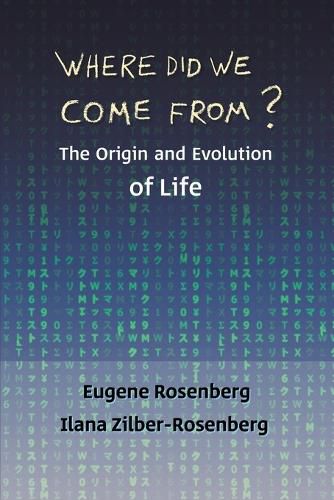Readings Newsletter
Become a Readings Member to make your shopping experience even easier.
Sign in or sign up for free!
You’re not far away from qualifying for FREE standard shipping within Australia
You’ve qualified for FREE standard shipping within Australia
The cart is loading…






This title is printed to order. This book may have been self-published. If so, we cannot guarantee the quality of the content. In the main most books will have gone through the editing process however some may not. We therefore suggest that you be aware of this before ordering this book. If in doubt check either the author or publisher’s details as we are unable to accept any returns unless they are faulty. Please contact us if you have any questions.
Where Did We Come From? The Origin and Evolution of Life is a welcoming introduction to the understanding of the origin and evolution of life. The authors capture the attention of all readers, be they well versed in theories of the origin of life and the Theory of Evolution or those that possess little knowledge of these interesting subjects. The authors discuss the origin of life from religious narratives to scientific-based accounts, leading to the conclusion that we still do not know how life began, but strive to do so. The Theory of Evolution by Natural Selection, presented simultaneously by Charles Darwin and Alfred Wallace, is one of the greatest ideas of all time. However, new discoveries in molecular genetics, microbiology, and systems biology have necessitated an extension/revision of the classical frame of evolutionary theory. These new discoveries include epigenetics, alteration of the environment, learning and cultural transmission, and the role of microorganisms in the evolution of animals and plants: the hologenome concept. Where Did We Come From? The Origin and Evolution of Life also provides a glimpse of how theories of evolution can affect our understanding of social phenomena, such as motherhood and social standing, biological cooperation versus Social Darwinism, and collective memory. Through an accessible authorial voice and clarity, not burdened with superfluous jargon, the authors engage with readers and lead them to become well-informed on these captivating subjects.
$9.00 standard shipping within Australia
FREE standard shipping within Australia for orders over $100.00
Express & International shipping calculated at checkout
This title is printed to order. This book may have been self-published. If so, we cannot guarantee the quality of the content. In the main most books will have gone through the editing process however some may not. We therefore suggest that you be aware of this before ordering this book. If in doubt check either the author or publisher’s details as we are unable to accept any returns unless they are faulty. Please contact us if you have any questions.
Where Did We Come From? The Origin and Evolution of Life is a welcoming introduction to the understanding of the origin and evolution of life. The authors capture the attention of all readers, be they well versed in theories of the origin of life and the Theory of Evolution or those that possess little knowledge of these interesting subjects. The authors discuss the origin of life from religious narratives to scientific-based accounts, leading to the conclusion that we still do not know how life began, but strive to do so. The Theory of Evolution by Natural Selection, presented simultaneously by Charles Darwin and Alfred Wallace, is one of the greatest ideas of all time. However, new discoveries in molecular genetics, microbiology, and systems biology have necessitated an extension/revision of the classical frame of evolutionary theory. These new discoveries include epigenetics, alteration of the environment, learning and cultural transmission, and the role of microorganisms in the evolution of animals and plants: the hologenome concept. Where Did We Come From? The Origin and Evolution of Life also provides a glimpse of how theories of evolution can affect our understanding of social phenomena, such as motherhood and social standing, biological cooperation versus Social Darwinism, and collective memory. Through an accessible authorial voice and clarity, not burdened with superfluous jargon, the authors engage with readers and lead them to become well-informed on these captivating subjects.